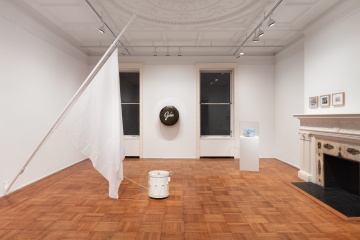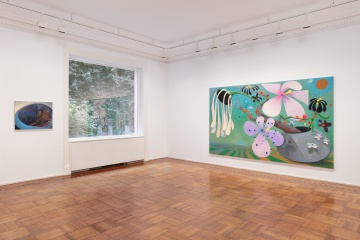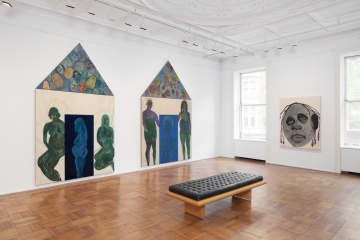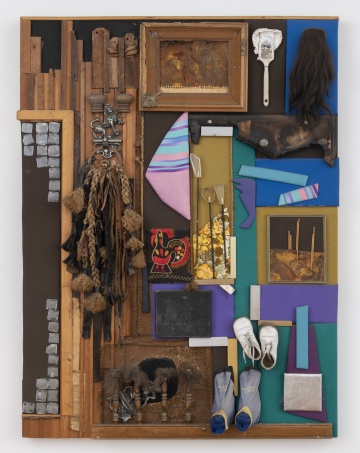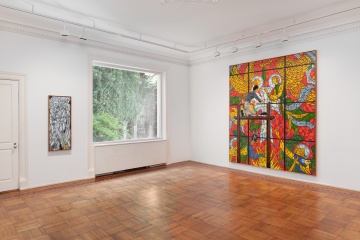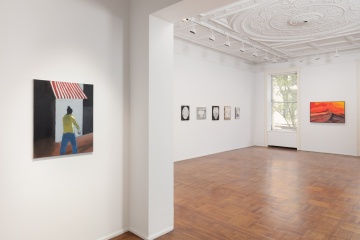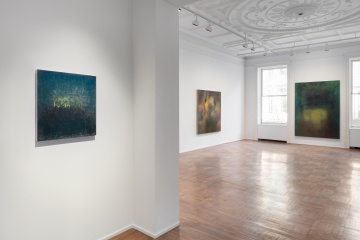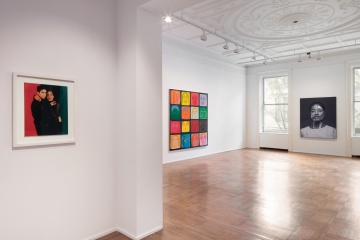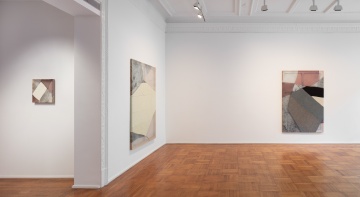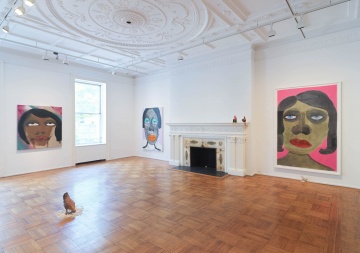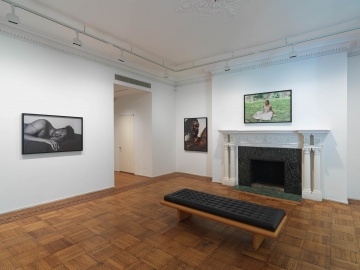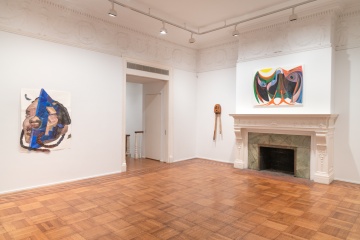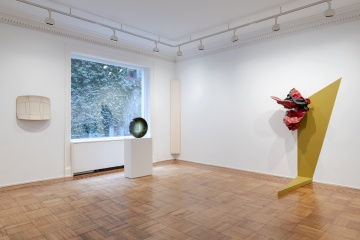Tilton Gallery
8 East 76th Street
New York, NY 10021
212 737 2221
New York, NY 10021
212 737 2221
Since 1983, the Tilton Gallery has been well known for discovering and promoting cutting edge, emerging artists from around the world. For more than three decades, Tilton has exhibited hundreds of contemporary artists, many of whom, like David Hammons, Marlene Dumas, Fred Tomaselli, Huang Yong Ping and Francis Alys, to name but a few, have become prominent figures on the international stage.
Now housed in a historic landmark Upper East side townhouse, the gallery’s current exhibition program continues to support our established gallery artists, and remains committed to discovering and cultivating new talent from around the globe.
The 2,400 square foot exhibition space is located on two floors at 8 East 76th Street, at 5th Avenue, New York. Within New York’s ‘museum mile,’ the gallery is in walking distance from The Metropolitan Museum of Art, The Guggenheim Museum and the Frick Museum, as well as many other Upper East side galleries.
Artists Represented:
Zachary Armstrong
Zachary Armstrong
Luca Dellaverson
Egan Frantz
Tomashi Jackson
Antone Konst
John Outterbridge
Rebecca Purdum
Noah Purifoy
Berend Strik
Texas Isaiah
Martha Tuttle
The Estate of Ruth Vollmer
Brenna Youngblood
Gang Zhao
Works Available By:
Derrick Adams
Derrick Adams
Noel Anderson
Wallace Berman
Ed Clark
Noah Davis
Marlene Dumas
Mel Edwards
Nicole Eisenman
Chitra Ganesh
Merik Goma
David Hammons
Yashua Klos
Jarbas Lopes
Senga Nengudi
Henk Peeters
Zhang Peili
Betye Saar
Sudarshan Shetty
Jeff Sonhouse
Richard Tuttle
Timothy Washington

Installation view courtesy Tilton Gallery.
Group: Art Club 2000, Leo Copers, Noah Davis, John Dogg, Nicole Eisenman, Derek Fordjour, Wade Guyton, David Hammons, Chris Johanson, Hans Namuth, Betty Parsons, Richard Prince, Henry Taylor, Rirkrit Tiravanija
Drum and Flag
November 9, 2023 - January 27, 2024
Tilton Gallery is pleased to present Drum and Flag, an exhibition of works that feature the sights and sounds of celebration. They depict celebrations of life, of people, of events big and small and in images and symbols both specific and abstract. Yet in all the works, a moment of melancholy creeps in. The moment is fleeting and the contradictions inherent in a celebration appear. The celebration of something implies the absence of something else. The moment of celebration must always end.
And yet, the celebrations begin again. They recur spontaneously and annually, for the once-in-a-lifetime and for the mundane of the everyday. People continue to come together through shared sights and sounds to capture, enjoy, and prolong moments and to find new ones. As one moment ends, the next begins. This invisible inertia propels us forward. It is manifest in the motion that’s seen and heard in these works. The undertow of melancholy is overcome by the current of celebration, coming in and going out like a wave.
This exhibition of celebratory works coincides with Tilton Gallery’s 40th anniversary. It features a mix of artists that the gallery has championed since its inception in 1983. Concurrent with the exhibition, a selection of additional works are installed in the gallery library by artists
February James, David Hammons, Ed Clark, and Richard Tuttle."
Antone Könst
Antone Könst: In a Sea of Nothing
September 6, 2023 - October 28, 2023
Tilton Gallery is delighted to present Antone Könst: In a Sea of Nothing, an exhibition of new paintings
depicting flowers, animals, and figures. This is Antone Könst’s second solo show with Tilton. The
exhibition will be on view from September 6 through October 28, 2023. A reception for the artist will
take place Wednesday, September 6th from 6:00 to 8:00PM.
In a Sea of Nothing comprises a group of figurative paintings depicting subjects from the natural world.
These subjects are universally familiar - flowers, animals and figures; however, they are not specific. The
flowers are not of a specific strain, the animals are not of a particular breed. The human figures are
recognizable as musicians or painters; yet they are not specific individuals. They express just enough of
themselves to convey what they are. This ambiguity and anonymity allow for a direct and deep expression
of emotion that is portrayed in paint through soft, strong, smooth, and rough brushstrokes.
Instinctual emotions of desire and isolation are always present. In the group of flower paintings, desire is manifest in the movement of each flower. They come to life as they strive for sustenance and reach into
the world around them, animated from stem to stamen. Rising out of their vases, they strain upwards and
outwards, held up by their thin stems. These supports convey strength in their angular joints, and grace in
their soft, swooping arcs. Each petal is unique, with a structure and color unto itself. Budding petals burst forward in bold colors and sharp forms. Wilting petals recede into shade in cool colors and drooping
shapes. At the center of the petals, stippled dabs of paint appear as seeds, pregnant with color and life.
These diverse elements and flowers come together as cohesive bouquets. The cacophony of colors and
forms express a multitude of emotions all felt at once.
The ambiguous animals and anonymous figures express a similar range of emotions but in a more
singular form of a lone animal or human. The image of a lion conjures notions of strength and violence.
Yet, here the lion appears cautious and tender, its head bowed and shoulders hunched. Its usual,
statuesque posture as an aggressor or guardian is called into question as the lion lets butterflies land on its muscular body. In Dancer with Flutes, a figure plays two flutes at once while dancing. Her jaunty frame
has the range of a musical score; her elbows and knees are emphatically angular, yet her limbs are draped
in a flowing garment adorned with soft circles of color.
While these subjects all appear large and push towards the edges of the canvas, their size is undermined
by the ground on which they stand. This ground is most often a grid, receding into an ambiguous depth.
The unknown expanse expresses the simultaneous smallness of the figures and a certain angst creeps in.
The large figures begin to feel isolated. The grid is at once familiar and foreign. It could be the domestic
surface of a bathroom or kitchen floor or a playful site like a checkerboard, but without any further
context it remains uncertain. The binary, geometric nature of the grid may now be more familiar as a
virtual surface, an infinite digital setting. Hovering above the grid circular forms appear, recognizable as suns or moons rising or setting off in the distance or perhaps orbiting planets floating nearby. These orbs transport the figures even further from a knowable setting. Set in an empty and endless landscape, these solitary subjects begin to feel almost absurd.
The title of the exhibition, In a Sea of Nothing, references this seeming absurdity. Despite the absence
around them, these figures have a presence and purpose. They exist and act in an unknown and isolated
world. The musicians keep playing without an audience. The lion steps forward bracing towards an
unknown. The flowers continue to bloom. These subjects have been painted for millennia, yet they
persist. There is still something new to be expressed and felt.
Antone Könst was born in 1987 in New Haven, Connecticut. He lives and works in Brooklyn, New York.
He received his BFA from the California Institute of the Arts in 2011 and his MFA from the Yale School
of Art in 2014. He has exhibited widely across the United States and abroad, with recent exhibitions in
New York, Taipei, Aspen, Los Angeles, and Paris. In 2018, Könst was awarded the Socrates Sculpture
Park Emerging Artist Fellowship. Recent public art commissions include Lighthouse Works, NY, and
Socrates Sculpture Park, NY. His work is included in the collections of the X Museum, Beijing, China;
Jorge Perez Collection Miami/promised gift to Pérez Art Museum Miami, Florida; and the Deji Art
Museum, Nanjing, China.
February James
February James: Gap Year
April 27, 2023 - June 30, 2023
Tilton Gallery is delighted to present February James’ second solo exhibition with the gallery. Gap Year will include paintings, watercolors, and installations. The exhibition will run from April 27th through June 30th. A reception for the artist will take place Thursday, April 27th from 6:00 to 8:00PM.
A gap year is, by definition, a break from study or work. Gap Year, the exhibition, provides a place of rest and retreat, a place to review and reflect and to commune with our inner self, our memories and the ancestors that have come before us.
February James centers this exhibition around the idea of the home, the place that contains the family, that resonates in one’s memory as the place from which we come and is the source of our outlook on the world, our religion, our diet, our ways of communicating. It is the first place that taught us about our
emotions and about love. As such, the home can be regarded as an altar of sorts, an image that remains in our hearts and minds.
James’ two largest multi-panel paintings, Love is the solution? and Make Our Dreams Synchronize, are in the shape of a home or house, painted with James’ signature figures. Large and with multiple figures, they are reminiscent of Renaissance altarpieces. A central rectangle, covered in velvet, also painted with another figure, acts as a type of doorway, suggesting the possibility of a passage into imagination, into the memory of the home or another world. The triangular “roof” is filled with a multitude of faces that represent the spirits and ancestors that fill the home, the familiar voices that fill one’s head. Home is where individual, though related, people come together, to live and eat and sleep, to communicate and relate. Home becomes the people who inhabit it, just as the body becomes a dwelling for spirit and
energy.
James’ paintings and watercolors of imaginary people, mostly women, fill the rest of the space, forming a
personal narrative. Her psychological portraits are abstracted, created in a painting style that prioritizes a loose handling of the materials and a unique color palette that depicts an interior emotional state rather than a recognizable individual.
One gallery space is transformed by a room-size installation, The Upper Room, where viewers can enter
and become a participant. The walls and low ceiling are covered in purple velvet; the floor is soft and
sinks with each footstep; the light is dim. A sense of disorientation is enhanced by the sound of people
talking, objects being moved, the type of noises experienced in a home. Small paintings, lit from above,
are hung high, like Byzantine icons; their size and positioning create a sense of both reverence and
intimacy. At the center of this liminal space are two chairs, also covered in velvet. Found and repurposed
or passed down through generations, they are emblematic of James’ repeated use of furniture that has its
own history as a symbol for the preservation of past memories. The viewer can sit and be transported into
the realm of contemplation, memory and imagination. The Upper Room becomes a place where we can
commune with the spirits of passed loved ones.
February James was born and raised in Washington D.C. and currently lives and works in Los Angeles,
CA. She received her BFA from the Art Center College of Design in Pasadena, CA. She has exhibited in
New York, Los Angeles, Chicago, London, Berlin and Turin, Italy. James’ work is currently included in
What’s Going On, the inaugural exhibition at the Rubell Museum in Washington, D.C. In 2021, James
was invited by Mickalene Thomas and Racquel Chevremont to create a room size installation in Set It Off,
an exhibition they organized for the Parrish Art Museum in Watermill, NY. She has been featured in
multiple other group shows, including Punch, curated by Nina Chanel Abney at Jeffrey Deitch in Los
Angeles, Face-to-Face at the Sugar Hill Children’s Museum of Art and Storytelling, New York and
BodyLand, curated by Lauren Taschen at Galerie Max Hetzler in Berlin. She was invited to contribute
watercolors to a feature in The New York Times Style Magazine in February 2021. James has been
represented by Tilton Gallery since 2020.
Noah Purifoy
February 2, 2023 - April 19, 2023
"Noah Purifoy
February 2 – April 19, 2023
Tilton Gallery is delighted to present the second ever East Coast solo exhibition of work by Noah Purifoy, opening Thursday, February 2nd from 6:00 to 8:00PM. The exhibition will be on view through April 19th.
A pioneering artist of the California assemblage movement, Noah Purifoy was also a key figure in the Black Arts Movement in Los Angeles during the 1960s and ‘70s. For Purifoy, art and political activism went hand in hand. He believed that art is a powerful tool for social change and never ceased to combine advocacy with creativity.
Purifoy is known for his assemblages composed of found and recycled objects. As with John Outterbridge and other Los Angeles transplants who spent their early years in the South, repurposing of objects and materials was a way of living.
With a Master’s degree in social work and an interest in psychology, philosophy and art history, Purifoy was aware of the Surrealist and Dada traditions and the work with found objects of artists such as Kurt Schwitters and Marcel Duchamp, both of whom had solo shows curated by Walter Hopps at the Pasadena Museum of Art in 1962 and 1963, respectively. Purifoy’s own work applies the use of collage and assemblage to create both poetic and abstracted social commentary.
Purifoy’s vision, particularly in the works included in this exhibition, all from 1987 on, exhibits a wide- ranging freedom of expression. Some, such as his very classic assemblage construction Rags and Old Iron I (after Nina Simone) and the somewhat more figurative Earl “Fatha” Hines reference two jazz
greats. The importance of jazz to his work cannot be underestimated. He was immersed in this art form, central to cultural life in South Los Angeles and he frequently gathered friends to listen to music and talk about art in his home. Jazz provided a model for structuring his view of the world in an abstract, syncopated way that challenges tradition while remaining structurally tight.
Other works, such as Hanging Tree and Upstage are more overtly political. The first is self-explanatory and the latter a deeply personal portrayal of two black abstracted men wearing masks that represent tragedy and comedy. They appear “upstaged” by a third figure carrying a cane, possibly a female, possibly an elder sage, a metaphor for history, a subject that cannot help but include the legacy of slavery and the plight of the black man as he saw it. Both are among the more graphic images in his oeuvre.
Clown Princess and One White Paint Brush and a Pony Tail embody the full and joyful use of objects in combination. The central image in Clown Princess again is a mask, weeping and smiling at once, placed atop a chair embedded in the painting surface and decked out in gold trinkets and pearls. All sorts of other objects are present, from a skull to spools of thread, small jars, wooden shoe inserts, a silver tray, and collaged pieces of fabric, both fragments of domestic gingham materials placed together to appear flag- like and actual flags, to name just a few of the many elements. Perhaps it is a comment on the absurdity of life’s façade, possibly a reference to Princess Diana or simply a comment on the many facets of life. One White Paint Brush and a Pony Tail is also chock full of a variety of objects, perhaps a commentary on art making, also a metaphor for a full life. Both of these works were made when Purifoy himself was more advanced in age and contemplating life itself from that older viewpoint.
Yet other works such as Joshua Tree and River Runs Dry are more purely abstract, the one reveling in color and paint and the other a graphic two-toned structure, both focusing on the environment, in homage to the desert milieu where he lived from 1989 until his death in 2004.
Rounding out this exhibition is a group of smaller assemblages mounted on board, framed by the artist, also late 1980s to early 1990s. Made of collaged found metal and wood and simpler in construct than his large works, they hark back to the kind of assemblages he first made in the 1960s at the time of the Watts Rebellion, focusing both on material and form.
Purifoy worked as a social worker in Cleveland in the late 1940s and as a furniture designer, among other occupations, after moving to Los Angeles in 1950. He was the first African American student to enroll at Chouinard (now the California Institute of the Arts or Cal Arts), where he received his Bachelor of Fine Arts. In 1964-1965, together with Judson Powell and Sue Welsh, Purifoy founded the Watts Towers Arts Center next to Simon Rodia’s legendary Watts Towers, itself a quintessential example of assemblage on a grand scale. He was director of the Center till 1975.
The Watts Arts Center was at the epicenter of the Watts Rebellion in August 1965. Purifoy and other artists created works of art from remnants collected in the resulting debris. With these, he organized the landmark exhibition 66 Signs of Neon. First shown in 1966 at local festivals and high schools, it then travelled to institutions nationwide and even to Germany through 1972. With this exhibition Purifoy created a portrait of the community of Watts out of found materials charged with immediacy, understanding that he could use art as a vehicle for communication. Out of this connection between art and the social and political urgency of the moment, Purifoy, in his words, “became an artist.”
In 1976, Purifoy gave up making art to initiate community programs and arts organizations through his appointed position on the California Arts Council. Purifoy left the Council in 1987 to return to being a full time artist in Los Angeles. In 1989, he moved to Joshua Tree where he worked outdoors in the desert, creating over 100 sculptures spread across ten acres of land, now preserved as the Noah Purifoy Outdoor Museum. He continued to make indoor constructions as well, the focus of this exhibition, also still made from recycled found materials.
Noah Purifoy was born in 1917 in Snow Hill, Alabama and died in 2004 in Joshua Tree, California. He had a Bachelor of Science from the Alabama State Teachers College, a Master’s in Social Service Administration from Atlanta University, and a Bachelor of Fine Arts from the Chouinard Art Institute. His works are included in the collections of the Whitney Museum of American Art and the Museum of Modern Art in New York, the San Francisco Museum of Modern Art, the National Gallery of Art and the Smithsonian Archives of American Art in Washington, D.C., the Hammer Museum, the Los Angeles County Museum and the California African American Museum in Los Angeles, and the Blanton Museum of Art, Austin among many others.
Purifoy’s work has been shown in exhibitions at the Whitney Museum of American Art, The Studio Museum in Harlem, the Los Angeles County Museum of Art, the Hammer Museum, and the California African American Museum, among other venues. His work was included in the traveling exhibition Now Dig This! Art and Black Los Angeles 1960-1980 at the Hammer Museum and MoMA PS1 in 2011-12. The California African American Museum gave Purifoy a retrospective in 1997, Noah Purifoy: Outside and in the Open. In 2015, the Los Angeles County Museum of Art organized a major retrospective of his work, Noah Purifoy: Junk Dada, which travelled to the Wexner Center for the Arts. Both exhibitions are accompanied by in-depth catalogues. Purifoy’s work was included in Soul of a Nation: Art in the Age of Black Power, organized by the Tate Modern and travelled to five other venues in 2018-2019. Extensive documentation on Purifoy can be found both in the Now Dig This! catalogue and in Tilton Gallery’s L.A. Object & David Hammons Body Prints. Tilton Gallery included Purifoy’s work in their exhibition of the same name in 2006; his first solo show with the gallery was in 2018.
Tomashi Jackson
Tomashi Jackson: The Great Society
November 10, 2022 - January 28, 2023
Tilton Gallery is delighted to present Tomashi Jackson: The Great Society, November 10th through January 28th. This will be Jackson’s third solo show at the gallery. A reception for the artist will take place on Thursday, November 10th from 6:00 to 8:00 pm.
In The Great Society, Tomashi Jackson continues to explore past legislation and key moments of history that are emblematic of times of important change and that are relevant to the present. She selects images that embody the spirit as well as facts of those moments to examine these historical events for their impact, heedful of how they resonate in our current time. For this exhibition, images taken from the public domain focus on three events where the possibility and promise of a great society was presented to audiences public and private in 1963, 1965, and 1969.
Jackson looks at President Lyndon Baines Johnson’s first formal speech about his intentions for the Great Society, given at the University of Michigan in 1963. Images are taken from the audience as they listen to him talk about his proposed legislation. Other images, from 1965, show young Black organizers meeting with him regarding the policies in that legislation on voting rights. These images from 1963 and 1965 collide with images of an audience applauding and cheering after a performance of “To Be Young, Gifted and Black” by Nina Simone at Morehouse College in 1969. Jackson looks at these high points from the 1960s with all their implications in relationship to the present unravelling of that same legislation.
Some of these images are embedded in her large and vibrantly colored canvases, projected onto and painted in halftone lines into her abstract, increasingly expressionist, surfaces. Other images are printed onto colorful marine vinyl strips that are layered over these painted surfaces. The collision of subject matter is echoed in the collision of the two material color surfaces. The superimposition of color upon color and image upon image emphasizes the relationships both formal and in content. Additional symbolism emerges as one learns that the painted surfaces are all embedded with marble dust taken from the Yule Mountain Quarry, the same site in Colorado from which the marble used for the Lincoln Memorial came.
The paintings are supported by three-dimensional handmade wood structures that act as stretchers, protruding from the wall in a triangular shape. This allows the hanging vinyl strips, extending beyond the bottom of the stretchers, to project color onto the wall itself, while the strips’ transparency acts physically and metaphorically to allow one to see multiple colors and images at once.
Tomashi Jackson was born in Houston, Texas in 1980 and grew up in Los Angeles, California. She received her MFA in Painting and Printmaking from the Yale University School of Art in 2016; earned her Master of Science in Art, Culture and Technology from the MIT School of Architecture and Planning in 2012; and her BFA from Cooper Union in 2010. She was a Resident Artist at the Skowhegan School of Painting & Sculpture in 2019; the recipient of the 2022 Roy R. Neuberger Prize and received a Joan Mitchell Foundation Painters and Sculptors Grant in 2020.
Jackson currently has an exhibition (SLOW JAMZ) focusing on her videos, which she views as experiments in painting, at the Neuberger Museum of Art, Purchase, NY, on view through November 27th. Other solo museum exhibitions have taken place at the Parrish Art Museum, Watermill, NY (The Land Claim) and at the Radcliffe Institute for Advanced Study at Harvard University (Brown II), both in 2021; the Wexner Center for the Arts, Columbus, Ohio (Love Rollercoaster) in 2020; and the Zuckerman Museum of Art, Kennesaw University, Kennesaw, GA (Interstate Love Song) in 2018. Jackson will have a major survey of her multidisciplinary work of paintings, sculptures and videos at the Museum of Contemporary Art, Denver, scheduled to open in June of 2023. Catalogues for the exhibitions at the Neuberger Museum, Radcliffe Institute and the Parrish Art Museum reflect the in-depth original research behind these shows as well as the exhibited works.
Jackson’s work has been included in group exhibitions at the High Museum of Art, Atlanta; The Guggenheim Museum, New York; the Boston Museum of Fine Arts; the Baltimore Museum of Art; The Museum of Contemporary Art, Los Angeles and the Institute for Contemporary Art, Virginia Commonwealth University, Richmond, VA among many others. Jackson was included in the 2019 Whitney Biennial.
Works by Jackson are in the collections of MOCA, Los Angeles; the Whitney Museum of American Art, New York; the Perez Art Museum Miami; the High Museum of Art, Atlanta; the Carnegie Museum of Art, Pittsburgh; the Guggenheim Museum, New York; the Boston Museum of Fine Arts; the Baltimore Museum of Art; the Parrish Art Museum, Watermill, NY; and the Studio Museum in Harlem, among others.
Tomashi Jackson lives and works in Cambridge, MA and New York City.
Zachary Armstrong
Zachary Armstrong: Bits & Pieces Put Together to Present a Semblance of a Whole
September 6, 2022 - October 29, 2022
Zachary Armstrong: Bits & Pieces Put Together to Present a Semblance of a Whole
September 6 - October 29, 2022
Reception: Wednesday, September 14th
Tilton Gallery is pleased to present Bits & Pieces Put Together to Present a Semblance of a Whole, an exhibition of new paintings and sculptures by Zachary Armstrong. This is Armstrong’s third solo show with the gallery. The exhibition will be on view from September 6th through October 26th, 2022. A reception for the artist will take place Wednesday, September 14th from 5:00PM to 8:00PM.
Bits & Pieces Put Together to Present a Semblance of a Whole is a title taken from a work by Lawrence Weiner that, for Armstrong, encapsulates his desire in this exhibition to gather a wide variety of interests and areas of conceptual exploration into one show.
In this exhibition, Armstrong continues to create his own blend of Americana with art history. The works, densely installed, touch upon multiple aspects of his repertory of imagery. Some paintings are beautiful and complex abstractions, painted in layers of encaustic, his chosen medium for painting. Underlying colors rise through an overlay of primarily blacks and whites and grays, brushstrokes overlaid with dynamic thick lines that seem to dance across the surface and evoke both flatness and depth simultaneously. Figurative paintings depict various of his personalized wide range of realistic images, again created in encaustic brushstrokes, often with an emphasis on the abstract nature of the shapes within.
Armstrong’s work requires one to take a leap into the artist’s head, to see what he sees, to revel in detail, in complexity, in the minutia that make up our world, both abstract and realistic. Objects are not only seen as subject, although the meaning of each image is, for Armstrong, usually important in some intensely personal way as a reference to his own history, his own inner library of images that have influenced his vision of the world, or arising from his deep knowledge of art history. Many of the figurative works in this exhibition depict his own version of Americana, whether in an appropriation of a Norman Rockwell painting or in his oversized images of farmyard animals.
The choice of images becomes important, not only for these objects’ inherent structure and detailing, and for their personal significance, but for the possibilities they present to the artist: what he can “pack into them.” This is a phrase the artist often repeats. A simple illustration, be it of a head, a figure, a fish, a chicken, or an appropriated, becomes a whole world, packed with a plethora of forms, colors, and brush strokes. Detail and repetition are essential.
A few images, such as those of a large engine or sewing machines, are chosen for their simplicity and simultaneous intricacy: they are simple, mechanical and precisely painting. They were perfectly engineered objects before being touched by human hand. With Duchamp’s Coffee Grinder or Man Ray’s sewing machine in mind, the choice of these found objects may also be seen as a nod to the famous Dada description of “a chance encounter of an umbrella and sewing machine on an operating table.”
For this exhibition, Armstrong has also made a large sculptural installation that spans the entire east wall of the large second floor gallery, from floor to ceiling, surrounding the room’s fireplace. One hundred and twenty carved and painted fish cover the wall, each with its individual shape and creating an overall symmetrical abstract configuration where the left side mirrors the right. The black and white patterned surfaces of these fish echo the larger abstract paintings in the exhibition. Armstrong feels that this work can be viewed simultaneously as a large sculptural installation and as a large painting.
Armstrong’s repeated return to depicting fish stems from Jack Tilton’s recounting a story about Betty Parsons. An artist as well as gallerist, she painted found driftwood in the shape of a fish and would give these sculptures to friends to hang above the entrance of the house to protect their homes from fire. Armstrong has used this inspiration to carve and paint fish to make bronze sculptures, playing with and distorting shapes and sizes. Here, the fish become pattern and ornamentation in this already ornate 1895 ballroom.
Zachary Armstrong was born in 1984 in Dayton, Ohio. Solo exhibitions include Grids & Abstracts at The Contemporary Dayton, OH and Bag of Candles at the Faurschou Foundation, Beijing, China, both in 2021. He has shown widely at galleries in London, Berlin, Copenhagen, Los Angeles and San Francisco. Armstrong’s work has been included in notable group exhibitions such as Take Up Space at the Pizzuti Collection and Inherent Structure at the Wexner Center for the Arts, both in Columbus, Ohio. Concurrent with his show at Tilton, the Faurschou Foundation, a private museum in Brooklyn, will present Twelve Animals, opening September 10th. Armstrong lives and works in Dayton, Ohio.
Marissa Cote, Isabella De Matteo, Braden Hollis, Matthew Li, Ernesto Renda, Ivan Ríos-Fetchko, Raya Terran
Surprise!
May 19, 2022 - August 25, 2022
Tilton Gallery is pleased to present Surprise!, a group exhibition of emerging artists, co-curated with Tomashi Jackson. The artists Marissa Cote, Isabella De Matteo, Braden Hollis, Matthew Li, Ernesto Renda, Ivan Ríos-Fetchko, and Raya Terran were all Jackson’s former students who continue to make interesting work and expand their practices. This group of artists studied at the Rhode Island School of Design, Providence; Cooper Union, New York and the Massachusetts College of Art and Design, Boston. Works vary from paintings to sculptures to mixed media to conceptual installation.
Marissa Cote studied at the School of the Art Institute of Chicago in 2014 and Imagery and
Color in Jacquard Weaving at Peters Valley School of Craft in 2017. She received her MFA
from the Massachusetts College of Art and Design in 2018. Her solo exhibition, I promise to stay in touch, will take place at Distillery Gallery in Boston later this year. Cote lives and works near Boston, MA.
Isabella De Matteo (b. 1996, Centerport, NY) received her BFA from The Cooper Union in
2019. Her solo exhibition, winsomeloving, took place at The Cooper Union that same year. She
will participate as a resident in the Vashon Island Residency in Vashon, Washington later this
year. De Matteo lives and works in Queens, NY.
Braden Hollis (b. 1998, Los Angeles, CA) studied at the Andrew Mellon Curatorial Academy at
LACMA in 2018, and received her BFA from The Cooper Union in 2020. Hollis was awarded
the Sylvia Appelman Painting Award in 2019. Her solo exhibition, Painstaking, will take place
in Los Angeles later this year. Hollis lives and works in Los Angeles, CA.
Matthew Li (b. 1999) received his BFA from The Cooper Union in 2022, and is a candidate for
his MFA from the Milton Avery Graduate School of Arts at Bard College in 2025. His solo
exhibitions Memory Impressions and Life In Between took place at The Cooper Union in 2020
and 2022 respectively. Li lives and works in New York, NY and Toronto, ON.
Ernesto Renda (b. 1995, New Jersey) received his BFA in Painting from the Rhode Island
School of Design and his BA in Modern Culture and Media Studies from Brown University in
2018. He received the Brown Arts Initiative Student Project Grant in 2017, the Brown Arts
Initiative Fellowship at Performa Biennial New York in 2018, and the Silver Arts Projects
Residency in 2021. Recent exhibitions include Dithering at Moskowitz Bayse Gallery in 2020,
and Christian Franzen / Ernesto Renda at In Lieu Gallery in 2022, both in Los Angeles, CA.
Renda lives and works in New York, NY.
Ivan Ríos-Fetchko (b. 1994, Los Angeles, CA) received his BFA in Painting from the Rhode
Island School of Design and his BA in Comparative Literature from Brown University in 2018.
He participated in the Residency at the Surf Point Foundation in York, ME in 2022. Ríos-
Fetchko lives and works in Los Angeles, CA.
Raya Terran (b. 1996, Marin County, CA) studied at the Slade School of Fine Art, London, UK
in 2018, and received her BFA from The Cooper Union, New York, NY in 2019. Solo
exhibitions include Mother of a Friend at The Cooper Union in 2019, Brethren of The Yard at
Rubber Factory in 2020, and Stills from the Migratory Ballad at Yossi Milo Gallery in 2021, all in New York, NY. Terran lives and works in Brooklyn, NY.
Rebecca Purdum
Rebecca Purdum: Selected Works 1986 to 2021
March 8, 2022 - May 14, 2022
Rebecca Purdum: Selected Works 1986 to 2021
March 8 – May 14, 2022
“Paint is a catalyst for a unique emotional and aesthetic encounter. It requires a kind of surrender, a kind of transparency on the part of the painter to allow paint to have an effect. When that happens, just like when you let anything alone long enough to be what it is rather than what you want it to be, an encounter occurs which I think is the art of abstract painting.” Rebecca Purdum, 2007
Tilton Gallery is thrilled to present a selection of paintings by Rebecca Purdum. They span the years from 1986, when she first exhibited with the gallery, through recent paintings from 2021. This will be her eleventh solo show with Tilton Gallery.
Rebecca Purdum is an abstract painter who, from her twenties, has had a clear vision of where her calling lies and has consistently pursued her own path. As an abstract painter, Purdum creates works that are both thoroughly contemporary and uniquely distinguishable from those by other artists. Purdum searches for meaning in the very act of painting. She paints directly on the canvas surface with gloved hands, giving her, as she once said, the equivalent of ten simultaneous brushes and allowing her to
work from within the painting, to become part of the painting.
Purdum creates timeless, often mysterious paintings that emanate an inner light from within their gently varied, often lush colors. There are shapes, but not shapes that you can name; there is nothing descriptive in these works.
In many, colors and paint merge, smoothed over to create a lustrous surface. In others, particularly those of the 2000s, paint strokes hover quietly on the surface and have a textured feel, giving off an almost vibrating sort of light. In recent paintings, somehow both things happen. It is remarkable how, in thirty five years of work, there is no repetition; each painting is its own exploration of paint, of mood, of an abstract representation of the inner energy of life.
Purdum’s paintings do what the best of abstract – or any – art should do: her work gives one that unnamable depth of experience that silently contributes to one’s understanding of the world. Purdum’s paintings continue to open our eyes to new possibilities in life and in art and deserve a slow and careful look.
Rebecca Purdum, born in 1959 in Idaho Falls, is an artist based in Ripton, Vermont. Her work was included in the 1991 Whitney Biennial and has been featured in exhibitions, among others, at the Modern Art Museum of Fort Worth, TX (1989), the Carnegie Mellon University Gallery, Pittsburgh, PA (1991), the Virginia Museum of Fine Arts, Richmond, VA (1994) and the Hood Museum of Art, Hanover, NH(2003). Her solo exhibitions include Art Now: Rebecca Purdum at the Middlebury Museum of Art, Middlebury, VT in 2007 and Breathing Painting at the New York Studio School of Drawing, Painting, and Sculpture, New York in 2021. Purdum completed the Skowhegan School of Painting and Sculpture
Summer Residency in 1981 and received the Louis Comfort Tiffany Foundation Award in 1991, the Joan Mitchell Foundation Grant in 2005 and the Peter S. Reed Foundation Grant in 2019. Her work is included in the collections of the Hood Museum of Art, the Fort Worth Art Museum, the Herbert F. Johnson Museum of Art, Cornell University and the List Visual Arts Center, MIT. Purdum has been represented by Tilton Gallery since 1986.
Portraits
November 10, 2021 - March 3, 2022
Tilton Gallery is pleased to present a group exhibition of portraits in varied media by multi-generational artists. Examples also go back in time to Early American portrait paintings, an Olmec stone head circa 500 B.C., and a carved 19th century ship's figurehead.
The face has long been seen as a mirror into the soul. And this is what the best of portraiture is truly about, going deeper into the personality of the sitter (real or imagined), not merely a depiction of the outer physical characteristics.
The artists in this exhibition go beyond the depiction of outer appearances to delve into the inner feelings of their subjects and in doing so, search for the meaning of humanity. Some artists like Genevieve Gaignard or Douglas Gordon do so with humor, irony and conceptual acuity. Others, like February James and Kohshin Finley, actively seek to understand and convey human feeling. Marlene Dumas does both: she depicts the human condition through a combination of emotion and conceptual distancing. David Hammons and Timothy Washington use their own images to
make social and political commentary, subtle or direct. Titus Kaphar’s portraits from the "Jerome" series show tenderness while also conveying social implications. And Noah Davis searches the core of humanity in his figurative paintings. Early American portraiture like that of Ammi Phillips or William M.S. Doyle was commissioned, but the best of these artists draw the viewer into the sitter’s psyche.
Styles and mediums in this exhibition range widely. In all, however, the surface is not merely the surface. This varied group of portraits of diverse modes and periods share an intensity of feeling and impact, be it emotional or conceptual.
The artists in this exhibition include: Philip Akkerman, Kai Althoff, Edward Curtis, Noah Davis, Wim Delvoye, William M.S. Doyle, Marlene Dumas, February James, Kohshin Finley, Genevieve Gaignard, Douglas Gordon, David Hammons, Lyle Ashton Harris, Rebecca Howland, Titus Kaphar, Matvey Levenstein, Ma Liuming, Timothy Washington
Martha Tuttle
Martha Tuttle: Wild irises grow in the mountains
September 15, 2021 - November 6, 2021
Do you remember the trees?
I remember when it was covered with trees. I remember when the grasses were taller than me.
And yellow, golden.
Yeah, and flowering, and then there was…not lamb’s ear, but purslane
Purslane, yes.
And you could eat it.
And I remember, it was really snowy, and really cold.
Yes, the cold.
And I remember not being able to leave the house, because it was so muddy.
And having so many boots for mud.
And each one, weighed like twenty pounds.
But those memories… it feels like a second ago, but it was already twenty-eight, thirty years ago.
Doesn’t seem like so much time to have so much change.
- Fragment of conversation taken from Drought
How long is lasting long enough? How do we experience climate shift as something that happens to us? What do we do with our grief?
Tilton Gallery is delighted to announce the opening on Wednesday, September 15, 2021 of Wild irises
grow in the mountains, an exhibition of new work by Martha Tuttle. There will be a reception for the artist from noon till 8 pm.
In her third solo exhibition with Tilton Gallery, the artist will present a group of ten large paintings and a video. An interplay between malleability and permanence, fragility and strength permeate the exhibition, ranging from perceptions about the vulnerability of traditional dyes and textile practices to the grief and mourning that strive to encounter the magnitude of climate change.
“I think that the question of how to care throughout change—even if that change is distressful—is one that can be seen as symbolized by the object and extending into the realms of the body and the earth,” the artist writes. “How do we learn to create a culture of care that moves with the needs of that which we care for? How do we disentangle ideas of health from desires for infinite usability and production?”
Ten wall works continue the artist’s practice of putting textile elements into delicate equilibrium. To make the paintings, Tuttle spins and weaves wool to make a sculptural material that she sews into compositions with silk, which are in turn painted with stone pigments and plant dyes. The paintings are then stretched around aluminum and wood stretchers. For the artist, this incorporation of the industrial avoids a strict separation between the supposedly organic and inorganic.
Drought (2021), the artist’s first video, expands her techniques of juxtaposition. The work overlays conversations between the artist and her mother—poet Mei Mei Berssenbrugge— about their experiences of developing drought with footage of the North American Southwest.
Martha Tuttle was born in Santa Fe, New Mexico in 1989. She received her BA from Bard College in
2011 and her MFA from The Yale School of Art in 2015. She has held residencies at the Rauschenberg
Foundation in Captiva, FL, 2019, the Sharpe-Walentas Studio Program in Brooklyn, NY and A-Z West in
Joshua Tree, CA, both 2017, and the UCross Foundation in Clearmont, WY, 2016. In 2014, Tuttle
received a Josef Albers Foundation Travelling Fellowship as well as a Donald C. Gallup Research
Fellowship from The Beinecke Rare Books and Manuscripts Library, Yale University. She has shown
widely in the U.S. and internationally, including in New York, Chicago, Los Angeles, Houston and Santa Fe as well as in Brussels, Belgium, Turin, Italy and Tokyo, Japan. Tuttle is represented by Tilton Gallery in New York where she had exhibitions in 2016 and 2018 and by Rhona Hoffman Gallery in Chicago, where she had a solo show in 2019. She currently has an outdoor sculpture exhibition, Outlooks: Martha Tuttle, at Storm King Art Center, open through November 8, 2021. Her work is in the collections of The Museum of Modern Art, New York, Smith College Museum of Art, Northampton, MA and the University of San Diego, CA. Tuttle lives and works in Brooklyn, NY.
February James
February James: When the Chickens Come Home To Roost
May 21, 2021 - September 11, 2021
Tilton Gallery is pleased to present “When the Chickens Come Home To Roost,” the first solo exhibition of paintings, watercolors and sculpture by February James in New York. The exhibition will open Friday,May 21st, noon to 8:00pm.
February James makes evocative portraits that respond to memory and are located at the nexus between the private self and public persona. They are both profoundly personal and non-specific, imbued with a sense of mystery that allows the viewer to engage with the work and collaborate with it to find their own interpretation.
Texas Isaiah
May 21, 2021 - September 11, 2021
Tilton Gallery is pleased to present a solo exhibition of photographs by Texas Isaiah, opening Friday, May 21st, noon to 8:00pm.
Texas Isaiah is a visual narrator whose photographs, primarily of Black people, especially those of queer, trans, non-binary and gender expansive experiences, create arresting and poignant portraits that are significant both for the subject matter and for their remarkable visual beauty, rich color and soft natural
light. Working in black and white and, more often since his move to Los Angeles a few years ago, in color
photography, Texas Isaiah captures the essential humanness of his sitters.
Kennedy Yanko
Kennedy Yanko: Postcapitalist Desire
April 6, 2021 - May 15, 2021
Tilton Gallery is pleased to present a solo exhibition of new sculpture by Kennedy Yanko, from April 6th to May 15th, 2021. We encourage visitors to call in advance on opening day to assure an even flow and safe viewing experience.
Kennedy Yanko continues her ongoing investigation into the combination of the seemingly incongruous materials of metal and paint skins to create voluptuous and unexpected sculptural forms. Salvaged metal, crushed or bent into new forms, is juxtaposed with lushly colored soft-appearing paint skins formulated by the artist to flow organically around or through the harder metal forms, at times seeming to pour out of this less pliant element.
Yanko melds the two materials and experiments with her very personal color palette to create works that defy the traditionally static nature of sculpture and that have a sense of continuous movement.
In this new body of work, Yanko has added a new element: wires. Straight and taut, they are threaded through the works like drawings in space, exerting pressure on the paint skins while extending the sculptures' essence beyond their perceived boundaries. They become yet another way that Yanko causes the viewer to think anew about the sculptures' relationships to walls and space and in turn to consider our own position in relation to these works within this cultural moment in time.
Kennedy Yanko is a Brooklyn-based artist, born in 1988 in St. Louis, Missouri. Yanko's work has been exhibited in group museum exhibitions including Parallels and Peripheries curated by Larry Ossei-Mensah at the Museum of Contemporary Art, Detroit in 2019 and Life During WarTime curated by Christian Viveros at the University of South Florida Contemporary Art Museum in 2020. She installed her first public sculpture, 3 WAYS, on the Poydras Corridor in New Orleans in collaboration with The Helis Foundation and the Ogden Museum of Art. Yanko has had solo exhibitions at the Urban Institute for Contemporary Art in Grand Rapids, Michigan; Jenkins Johnson Project Space, Brooklyn, NY, Denny Dimin Gallery, New York, Kavi Gupta Gallery, Chicago, and Vielmetter Gallery, Los Angeles. Yanko was named Artforum's "Critic's Pick," received a Colene Brown Art Prize awarded by BRIC Arts Media, and was featured in 100 Sculptors of Tomorrow published by Thames & Hudson.
Eduardo Abaroa, Kim Dingle, Huang Yong Ping, John Outterbridge, Noah Purifoy, Ruth Voller, Gang Zhao
Empty Legs
January 7, 2021 - March 27, 2021
Tilton Gallery is pleased to present Empty Legs, an exhibition of artworks that feature legs, or their conspicuous absence. Working around the globe and across generations, each artist uses legs as a way to say something about their attitudes and concerns, in other words, where they stood.
The exhibitions features works by Eduardo Abaroa, Kim Dingle, Huang Yong Ping, John Outterbridge, Noah Purifoy, Ruth Vollmer, Gang Zhao.
Empty Legs has been organized by Jacob Billiar. Simultaneous with this exhibition, Tilton Gallery
presents a group show of selected works by Egan Frantz, Tomashi Jackson, Yashua Klos, Antone Könst, Jarbas Lopes, John Outterbridge, Noah Purifoy, Joyce Scott, Berend Strik, Martha Tuttle, Cosima von
Bonin and Brenna Youngblood.
Egan Frantz, Tomashi Jackson, Antone Könst, Jarbas Lopes, John Outterbridge, Noah Purifoy, Joyce Scott, Berend Strik, Cosima von Bonin, Brenna Youngblood
Selected Works
January 7, 2021 - March 27, 2021
Tilton Gallery is pleased to present a group of Selected Works that hover between abstraction and figurative content. From the straightforward to political to ironic and self-critical, they are a group of favorites to ring in the New Year.
Group
Abstract! Minimalism to Now
February 11, 2020 - September 19, 2020
Zachary Armstrong, Ed Clark, Luca Dellaverson, Fred Eversley, Keltie Ferris, Egan Frantz, Terri Friedman, Ron Gorchov, Rashid Johnson, Sol LeWitt, Richard Nonas, Kianja Strobert, Chris Succo, Martha Tuttle, Richard Tuttle, Stanley Whitney, Kennedy Yanko, Robert Yasuda, Brenna Youngblood
Felipe Baeza, Jaclyn Conley, Kenturah Davis, Merik Goma, Christie Neptune, Alexandria Smith, Vaughn Spann
NXTHVN: First Year Fellows
November 5, 2019 - January 18, 2020
Works by the Studio Fellows at NXTHVN, upon completion of the first year of this Residency Program founded by Titus Kaphar, Jonathan Brand and Jason Price.
Antone Könst
Antone Konst: Love & Fear
September 11, 2019 - October 26, 2019
Nicole Eisenman
Nicole Eisenman: Nineteen Nineties
September 11, 2019 - October 26, 2019
Tomashi Jackson
Tomashi Jackson: Time Out of Mind
April 30, 2019 - June 29, 2019
John Outterbridge
November 13, 2018 - January 19, 2019
Noah Purifoy
September 11, 2018 - November 3, 2018
East Coast/West Coast: Clark, Hammons, Outterbridge, Saar, Washington
September 11, 2018 - November 3, 2018
Zachary Armstrong
Zachary Armstrong: George
May 4, 2018 - June 28, 2018
In Tribute to Jack Tilton: A Selection from 35 Years
March 22, 2018 - April 28, 2018
Martha Tuttle
Martha Tuttle: I long and seek after
January 18, 2018 - March 11, 2018

 Back to all Member Galleries
Back to all Member Galleries
